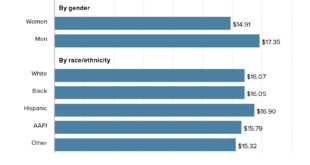
The graph here from the American Sociological Review paper Income inequality and Class Divides in Parental Investments by Schneider, Hastigs, and LaBriola (5/21/18) summarizes changes in spending on children by income.
The past 40 years have witnessed historic increases in income inequality in the United States (Piketty and Saez 2003). Over the same period, existing class divides—by household income and by parents’ educational attainment—in how much money parents spend on children and how much time parents spend in childcare have widened considerably (Altintas 2016; Kornrich and Furstenberg 2013; Ramey and Ramey 2010). These increasingly evident class divides in parental investments of time and money spark concern, because parental investment is an important factor in the intergenerational perpetuation of advantage (Downey, von Hippel, and Broh 2004; Potter and Roksa 2013; Waldfogel and Washbrook 2011). If affluent families are increasingly able to transmit their advantages to children, that bodes poorly for an open opportunity structure.
Of course,
We would expect rising income inequality to increase class gaps in parental financial investments in children mechanically if rising income inequality simply means the affluent have more to spend. But, rising income inequality might also widen class gaps in investments in children if it reshapes parents’ preferences for these practices differentially by class.
It is also possible that income inequality is not related to class gaps in parental investment. Indeed, recent work suggests a narrowing of gaps in early achievement by family income, and a narrowing or arrested divergence in some gaps in parenting practices, even as income inequality has continued to rise, raising questions about this often assumed empirical relationship (Kalil et al. 2016; Reardon 2011; Reardon and Portilla 2016).
We empirically investigate these questions.
The paper has interesting charts and data, and worth reading for their conclusions. Also, the supplemental materials include some mathematical modeling.
